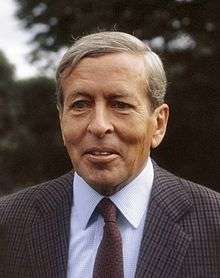Prince Claus of the Netherlands
| Claus von Amsberg | |||||
|---|---|---|---|---|---|
 Prince Claus in 1986 | |||||
| Prince consort of the Netherlands | |||||
| Tenure | 30 April 1980 – 6 October 2002 | ||||
| Born |
6 September 1926 Hitzacker, Germany | ||||
| Died |
6 October 2002 (aged 76) Academic Medical Center, Amsterdam, Netherlands | ||||
| Burial |
15 October 2002 Nieuwe Kerk, Delft, Netherlands | ||||
| Spouse |
Beatrix of the Netherlands (m. 1966) | ||||
| Issue |
Willem-Alexander of the Netherlands Prince Friso of Orange-Nassau Prince Constantijn of the Netherlands | ||||
| |||||
| House | Amsberg | ||||
| Father | Claus Felix von Amsberg | ||||
| Mother | Gösta von dem Bussche-Haddenhausen | ||||
| Religion |
Lutheranism (until 1966) Reformed (from 1966) | ||||
| Occupation |
Diplomat Civil servant | ||||
| Signature |
 | ||||
Claus George Willem Otto Frederik Geert van Amsberg (né Klaus-Georg Wilhelm Otto Friedrich Gerd von Amsberg; 6 September 1926 – 6 October 2002), later Prince Claus of the Netherlands, was the husband of Queen Beatrix of the Netherlands, and as such was Prince consort of the Netherlands from Beatrix's ascension in 1980 until his death in 2002.
Biography
Claus was born Klaus-Georg Wilhelm Otto Friedrich Gerd von Amsberg, on his family's estate, Schloss Dötzingen, near Hitzacker, Germany on 6 September 1926.[1] His parents were Claus Felix von Amsberg and Baroness Gösta von dem Bussche-Haddenhausen. His father, a member of the untitled German nobility, operated a large farm in Tanganyika (formerly German East Africa) from 1928 until World War II. From 1938 Claus and his six sisters grew up on their maternal grandparents' manor in Lower Saxony; he attended the Friderico-Francisceum-Gymnasium in Bad Doberan from 1933 to 1936 and a boarding school in Tanganyika from 1936 to 1938.
Claus was a member of such Nazi youth organisations as Deutsches Jungvolk and the Hitler Youth (membership in the latter was mandatory for all fit members of his generation).[2] From 1938 until 1942, he attended the Baltenschule Misdroy.
In 1944, he was conscripted into the German Wehrmacht, becoming a soldier in the German 90th Panzergrenadier Division in Italy in March 1945, but taken as a prisoner of war by the American forces at Meran before taking part in any fighting. After his repatriation, he finished school in Lüneburg and studied law in Hamburg. He then joined the German diplomatic corps and worked in Santo Domingo and Ivory Coast. In the 1960s, he was transferred to Bonn.
Claus met Princess Beatrix for the first time on New Year's Eve 1962 in Bad Driburg at a dinner hosted by the count von Oeynhausen-Sierstorpff who was a distant relative of both of them. They met again at the wedding-eve party of Princess Tatjana of Sayn-Wittgenstein-Berleburg and Moritz, Landgrave of Hesse, in the summer of 1964. With memories of German oppression still very strong 20 years after the war, sections of the Dutch population were unhappy that Beatrix's fiancé was a German and former member of the Hitler Youth. Nonetheless, Juliana gave the engagement her blessing after giving serious thought to canceling it. The engagement was approved by the States-General—a necessary step for Beatrix to remain heiress to the throne—in 1965. He was granted Dutch citizenship later that year and changed the spellings of his names to Dutch.
The pair were married on 10 March 1966. Their wedding day saw violent protests, most notably by the anarchist-artist group Provo. They included such memorable slogans as "Claus, 'raus!" (Claus, get out!) and "Mijn fiets terug" (Give me back my bike), a reference to the memory of occupying German soldiers confiscating Dutch bicycles. A smoke bomb was thrown at the wedding carriage by a group of Provos. For a time, it was thought that Beatrix would be the last monarch of the Netherlands.
However, over time, Claus became accepted by the public, so much so that during the last part of his life he was generally considered the most popular member of the Royal Family.[3] This change in Dutch opinion was brought about by Claus's strong motivation to contribute to public causes (especially Third World development, on which he was considered an expert), his sincere modesty and his candor (within but sometimes on the edge of royal protocol).
The public also sympathised with Claus for his efforts to give meaning to his life beyond the restrictions that Dutch law imposed on the Royal Family's freedom of speech and action. However, these restrictions were gradually loosened; Claus was even appointed as senior staff member at the Department of Developing Aid, albeit in an advisory role.
One example of his attitude toward protocol was the "Declaration of the Tie". In 1998, after presenting the annual Prince Claus Awards to three African fashion designers, Claus told "workers of all nations to unite and cast away the new shackles they have voluntarily cast upon themselves", meaning the necktie, that "snake around my neck," and encouraged the audience to "venture into open-collar paradise". He then removed his tie and threw it on the floor.[4]
In 2001, when on Dutch television he announced the marriage of his son Willem-Alexander, Prince of Orange, and Máxima Zorreguieta, an Argentine woman of Spanish and Italian descent, Prince Claus referred to himself as more a citizen of the world than anything else.
Titles, styles, honours, and arms
.svg.png)


Titles and styles
- 6 September 1926 – 1965: Klaus von Amsberg
- 1965 – 10 March 1966: Claus van Amsberg (His name was changed officially after obtaining Dutch citizenship)
- 10 March 1966 – 6 October 2002: His Royal Highness Prince Claus of the Netherlands, Jonkheer van Amsberg[5]
Honours and awards
See also List of honours of the Dutch Royal Family by country
Dutch orders and decorations
 Netherlands: Knight Grand Cross of the Order of the Netherlands Lion
Netherlands: Knight Grand Cross of the Order of the Netherlands Lion Netherlands: Knight of the Order of the Gold Lion of the House of Nassau
Netherlands: Knight of the Order of the Gold Lion of the House of Nassau Netherlands: Knight Grand Cross of the Order of the House of Orange
Netherlands: Knight Grand Cross of the Order of the House of Orange Netherlands: Royal Wedding Medal 2002 (2 February 2002)
Netherlands: Royal Wedding Medal 2002 (2 February 2002)
Foreign honours
-
 Austria: Grand Star of the Decoration of Honour for Services to the Republic of Austria (1994) [6]
Austria: Grand Star of the Decoration of Honour for Services to the Republic of Austria (1994) [6] -
 Germany: Grand Cross Special Class of the Order of Merit of the Federal Republic of Germany (1 March 1983)
Germany: Grand Cross Special Class of the Order of Merit of the Federal Republic of Germany (1 March 1983) -
 Iceland: Grand Cross of the Order of the Falcon (1994) [7]
Iceland: Grand Cross of the Order of the Falcon (1994) [7] -
 Norway: Grand Cross of the Royal Norwegian Order of Saint Olav (1986)[8]
Norway: Grand Cross of the Royal Norwegian Order of Saint Olav (1986)[8] -
 Portugal: Grand Cross of the Order of Christ (GCC, 14 May 1991)
Portugal: Grand Cross of the Order of Christ (GCC, 14 May 1991) -
 South Africa: Grand Cross of the Order of Good Hope (1999) [9]
South Africa: Grand Cross of the Order of Good Hope (1999) [9] -
 Spain: Knight Grand Cross of the Order of Charles III (7 October 1985)[10][11]
Spain: Knight Grand Cross of the Order of Charles III (7 October 1985)[10][11] -
 United Kingdom: Honorary Knight Grand Cross of the Royal Victorian Order (GCVO, 18 November 1982)[12]
United Kingdom: Honorary Knight Grand Cross of the Royal Victorian Order (GCVO, 18 November 1982)[12] -
 Italy: Knight Grand Cross with Collar of the Order of Merit of the Italian Republic (27 March 1985)[13]
Italy: Knight Grand Cross with Collar of the Order of Merit of the Italian Republic (27 March 1985)[13] -
 Denmark: Knight of the Order of the Elephant (RE, 29 October 1975)
Denmark: Knight of the Order of the Elephant (RE, 29 October 1975) -
 Japan: Knight Grand Cordon of the Order of the Chrysanthemum[14]
Japan: Knight Grand Cordon of the Order of the Chrysanthemum[14]
Academic awards
- Honorary Doctor of the International Institute of Social Studies (1988)
Prince Claus was also appointed Honorary Fellow of the International Institute of Social Studies (ISS) in 1988. Prince Claus was held in very high esteem in the international development cooperation community, partly because of his considerable insight and understanding of the problems involved, and partly because of his exceptional gift for expressing the hopes and anxieties felt by all.
Ancestry
| Ancestors of Prince Claus of the Netherlands | ||||||||||||||||||||||||||||||||||||||||||||||||||||||||||||||||||||||||||||||||||||||||||||||||||||||||||||||||||||||||||||||||||||||||||||||||||||||||||||||||||||||||||||||||||||||||||||||||||||||||||||||||||||||||||||||||||||||||||||||||||||||||||||||||||||||||||||||||||||||||||||||||||||||||||||||||||||||||||||||||||||||||||||||||||||||||||||||||||||||||||||||||||||||||||||||||||||||||||||||||||||||||||||||||||||||||||||||||||||||||||||||||||||||||||||||||||||||||||||||||||||||||||||||||||||||||||||||||||
|---|---|---|---|---|---|---|---|---|---|---|---|---|---|---|---|---|---|---|---|---|---|---|---|---|---|---|---|---|---|---|---|---|---|---|---|---|---|---|---|---|---|---|---|---|---|---|---|---|---|---|---|---|---|---|---|---|---|---|---|---|---|---|---|---|---|---|---|---|---|---|---|---|---|---|---|---|---|---|---|---|---|---|---|---|---|---|---|---|---|---|---|---|---|---|---|---|---|---|---|---|---|---|---|---|---|---|---|---|---|---|---|---|---|---|---|---|---|---|---|---|---|---|---|---|---|---|---|---|---|---|---|---|---|---|---|---|---|---|---|---|---|---|---|---|---|---|---|---|---|---|---|---|---|---|---|---|---|---|---|---|---|---|---|---|---|---|---|---|---|---|---|---|---|---|---|---|---|---|---|---|---|---|---|---|---|---|---|---|---|---|---|---|---|---|---|---|---|---|---|---|---|---|---|---|---|---|---|---|---|---|---|---|---|---|---|---|---|---|---|---|---|---|---|---|---|---|---|---|---|---|---|---|---|---|---|---|---|---|---|---|---|---|---|---|---|---|---|---|---|---|---|---|---|---|---|---|---|---|---|---|---|---|---|---|---|---|---|---|---|---|---|---|---|---|---|---|---|---|---|---|---|---|---|---|---|---|---|---|---|---|---|---|---|---|---|---|---|---|---|---|---|---|---|---|---|---|---|---|---|---|---|---|---|---|---|---|---|---|---|---|---|---|---|---|---|---|---|---|---|---|---|---|---|---|---|---|---|---|---|---|---|---|---|---|---|---|---|---|---|---|---|---|---|---|---|---|---|---|---|---|---|---|---|---|---|---|---|---|---|---|---|---|---|---|---|---|---|---|---|---|---|---|---|---|---|---|---|---|---|---|---|---|---|---|---|---|---|---|---|---|---|---|---|---|---|---|---|---|---|---|---|---|---|---|---|---|---|---|---|---|---|---|---|---|---|---|---|---|---|---|---|---|---|---|---|---|---|---|---|---|---|---|---|---|---|---|---|---|---|---|---|---|---|---|---|---|---|---|---|---|---|---|---|---|---|---|---|---|---|---|---|---|---|---|---|---|---|---|---|---|---|---|---|---|---|---|---|---|---|---|---|---|---|---|---|---|---|---|---|---|---|---|---|---|---|---|---|---|---|---|---|---|---|---|
| ||||||||||||||||||||||||||||||||||||||||||||||||||||||||||||||||||||||||||||||||||||||||||||||||||||||||||||||||||||||||||||||||||||||||||||||||||||||||||||||||||||||||||||||||||||||||||||||||||||||||||||||||||||||||||||||||||||||||||||||||||||||||||||||||||||||||||||||||||||||||||||||||||||||||||||||||||||||||||||||||||||||||||||||||||||||||||||||||||||||||||||||||||||||||||||||||||||||||||||||||||||||||||||||||||||||||||||||||||||||||||||||||||||||||||||||||||||||||||||||||||||||||||||||||||||||||||||||||||
Issue
| Name | Birth | Death | Notes |
|---|---|---|---|
| King Willem-Alexander | 27 April 1967 | He married Máxima Zorreguieta Cerruti in 2002, and has three daughters. | |
| Prince Friso | 25 September 1968 | 12 August 2013[15] | He married Mabel Wisse Smit in 2004, and had two daughters. |
| Prince Constantijn | 11 October 1969 | He married Laurentien Brinkhorst in 2001, and has two daughters and a son. |
Health and death

Claus suffered various health problems, such as depression, cancer and Parkinson's disease. He died in Amsterdam on 6 October 2002 after a long illness, aged 76. He died less than 4 months after the birth of his first grandchild.
He was interred in the Royal Family's tomb in Delft on 15 October. It was the first full state funeral since Queen Wilhelmina's in 1962.
References
- ↑ Simons, Marlise (7 October 2002). "Claus von Amsberg, 76, Popular Dutch Prince". The New York Times. Retrieved 27 September 2012.
- ↑ Hitler Youth: Prelude to War 1933–1939. The History Place. Retrieved on 23 April 2014.
- ↑ (Dutch) Máxima en Claus populairste Oranje-leden
- ↑ (Dutch) Claus' speech in which he removes his tie, among other video fragments
- ↑ Decree concerning the titles and names of Prince Claus after his marriage with Princess Beatrix – Website with Legislation concerning the Royal House of the Netherlands (Dutch)
- ↑ "Reply to a parliamentary question about the Decoration of Honour" (PDF) (in German). p. 111. Retrieved November 2012. Check date values in:
|access-date=(help) - ↑ State visit, Photo of Beatrix, Claus and Icelandese President
- ↑ Volks krant, State visit of Netherlands in Norway, 1986, Group Photo
- ↑ 1999 National Orders awards. Info.gov.za (18 September 2012). Retrieved on 23 April 2014.
- ↑ Boletín Oficial del Estado. 8 October 1985.
- ↑ Viva Máxima Blog, State visit of Beatrix in Spain in 1985, Group Photo
- ↑ Volks krant, State visit of Netherlands in United Kingdom, 11/1982, Group Photo
- ↑ Italian Presidency, S.A.R. Claus Principe dei Paesi Bassi – Decorato di Gran Cordone
- ↑ State Visit
- ↑ Prins Friso overleden (nl) Telegraaf.nl
External links
| Wikimedia Commons has media related to Prince Claus of the Netherlands. |
- In pictures: Prince Claus remembered
- Video: Condolences pour in, 7 October 2002
- Dutch Royal Family website: Biography
- Profile at The International Institute of Social Studies (ISS)
| Prince Claus of the Netherlands Born: 6 September 1926 Died: 6 October 2002 | ||
| Dutch royalty | ||
|---|---|---|
| Preceded by Bernhard of Lippe-Biesterfeld |
Prince consort of the Netherlands 1980–2002 |
Vacant until 2013 Title next held by Máxima Zorreguieta Cerrutias queen consort |